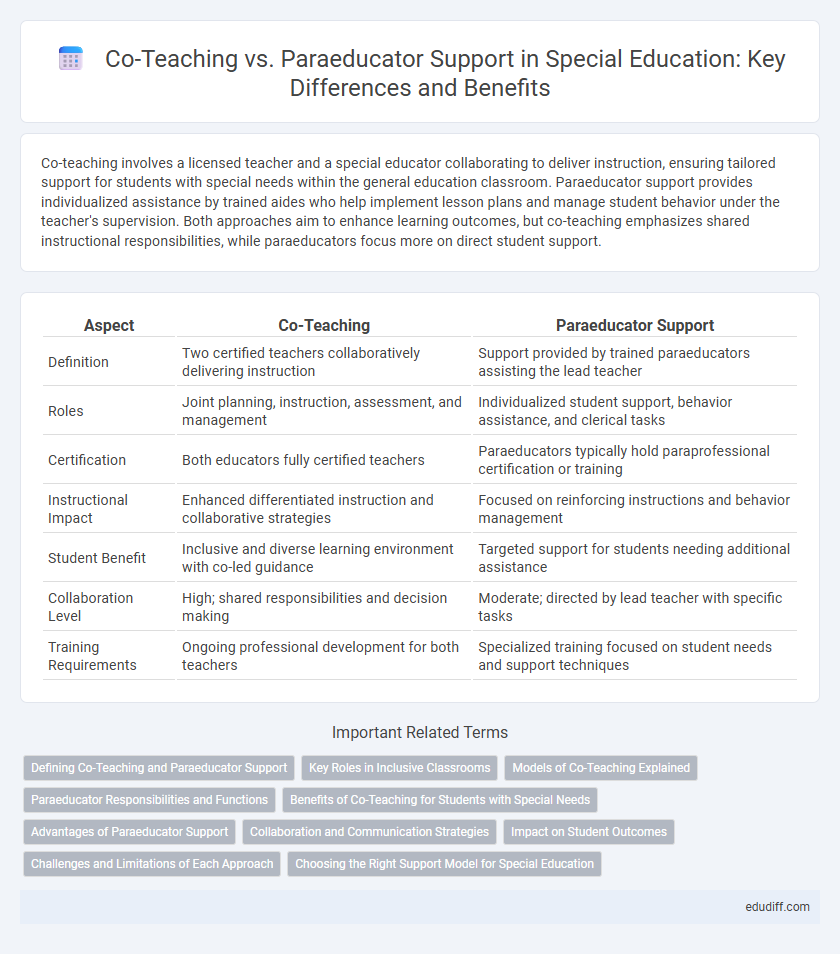Co-teaching involves a licensed teacher and a special educator collaborating to deliver instruction, ensuring tailored support for students with special needs within the general education classroom. Paraeducator support provides individualized assistance by trained aides who help implement lesson plans and manage student behavior under the teacher's supervision. Both approaches aim to enhance learning outcomes, but co-teaching emphasizes shared instructional responsibilities, while paraeducators focus more on direct student support.
Table of Comparison
| Aspect | Co-Teaching | Paraeducator Support |
|---|---|---|
| Definition | Two certified teachers collaboratively delivering instruction | Support provided by trained paraeducators assisting the lead teacher |
| Roles | Joint planning, instruction, assessment, and management | Individualized student support, behavior assistance, and clerical tasks |
| Certification | Both educators fully certified teachers | Paraeducators typically hold paraprofessional certification or training |
| Instructional Impact | Enhanced differentiated instruction and collaborative strategies | Focused on reinforcing instructions and behavior management |
| Student Benefit | Inclusive and diverse learning environment with co-led guidance | Targeted support for students needing additional assistance |
| Collaboration Level | High; shared responsibilities and decision making | Moderate; directed by lead teacher with specific tasks |
| Training Requirements | Ongoing professional development for both teachers | Specialized training focused on student needs and support techniques |
Defining Co-Teaching and Paraeducator Support
Co-teaching involves two licensed educators collaboratively delivering instruction to a diverse group of students within the same classroom environment, utilizing shared planning and responsibility for academic outcomes. Paraeducator support refers to trained instructional assistants who work under the direct supervision of licensed teachers to provide individualized assistance, behavior management, and supplementary academic support to students with special needs. Defining these roles clarifies the distinct responsibilities and enhances the effectiveness of inclusive education strategies.
Key Roles in Inclusive Classrooms
Co-teaching involves two licensed educators collaboratively delivering instruction and sharing responsibilities to meet diverse student needs, enhancing academic and social outcomes. Paraeducator support provides essential assistance by reinforcing classroom management, offering individualized attention, and facilitating accommodations under teacher guidance. Both roles are critical in inclusive classrooms to ensure access, equity, and meaningful participation for students with disabilities.
Models of Co-Teaching Explained
Models of co-teaching include One Teach, One Assist, Station Teaching, Parallel Teaching, Alternative Teaching, and Team Teaching, each designed to maximize instructional effectiveness and student engagement in special education settings. In contrast, paraeducator support typically involves providing targeted assistance to individual students or small groups under the supervision of a licensed teacher. Understanding the distinct roles within co-teaching models clarifies how collaborative instruction enhances learning outcomes compared to the more supplementary role of paraeducators.
Paraeducator Responsibilities and Functions
Paraeducators in special education provide critical support by implementing individualized instruction plans, assisting with behavior management, and facilitating communication between students and teachers. Their responsibilities include adapting materials, monitoring student progress, and supporting inclusive classroom environments to meet diverse learning needs. Unlike co-teachers, paraeducators focus primarily on direct student assistance rather than planning or delivering full lessons.
Benefits of Co-Teaching for Students with Special Needs
Co-teaching fosters inclusive learning environments by integrating general and special education expertise, enhancing instructional quality for students with special needs. Collaborative lesson planning and diverse teaching strategies promote individualized support and engagement, leading to improved academic and social outcomes. Shared responsibility between educators ensures consistent monitoring and adaptation to each student's unique learning requirements.
Advantages of Paraeducator Support
Paraeducator support enhances individualized instruction by providing targeted assistance tailored to diverse learner needs, fostering inclusive classroom environments. Their presence allows for continuous monitoring and immediate feedback, which improves student engagement and academic outcomes. Employing paraeducators also alleviates teacher workload, enabling educators to concentrate on curriculum development and complex instructional strategies.
Collaboration and Communication Strategies
Effective co-teaching and paraeducator support rely on strategic collaboration and clear communication to enhance student learning outcomes. Co-teaching models emphasize shared responsibility, requiring regular planning sessions and open dialogues between general and special educators to align instructional goals. Paraeducators benefit from explicit communication protocols that define roles and provide ongoing feedback, ensuring seamless integration into the classroom environment.
Impact on Student Outcomes
Co-teaching models demonstrate improved student engagement and higher academic achievement as certified teachers collaboratively design and deliver instruction, leveraging their specialized training. Paraeducator support contributes positively by providing individualized assistance and reinforcing learning objectives, yet its impact on standardized test scores is often less pronounced without direct instructional delivery. Studies indicate that combining both approaches strategically maximizes positive outcomes, enhancing inclusive education and student progress.
Challenges and Limitations of Each Approach
Co-teaching often faces challenges such as role ambiguity between teachers and paraeducators, leading to communication breakdowns and inconsistent instructional delivery. Paraeducator support can be limited by insufficient training and restricted authority, which diminishes their ability to manage diverse student needs effectively. Both approaches require clear collaboration guidelines and ongoing professional development to overcome these limitations and optimize student outcomes in special education settings.
Choosing the Right Support Model for Special Education
Choosing the right support model in special education hinges on understanding the distinct roles of co-teaching and paraeducator assistance. Co-teaching integrates two certified teachers collaboratively delivering instruction, enhancing curriculum adaptation and differentiated learning for diverse needs. Paraeducator support supplements instruction through individualized assistance, focusing on behavioral management and personal care, making it essential to align support strategies with student goals and resources.
Co-Teaching vs Paraeducator Support Infographic

 edudiff.com
edudiff.com